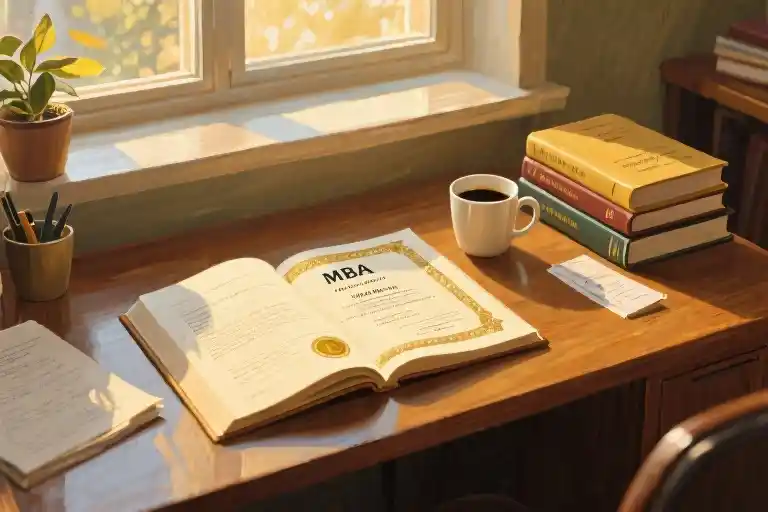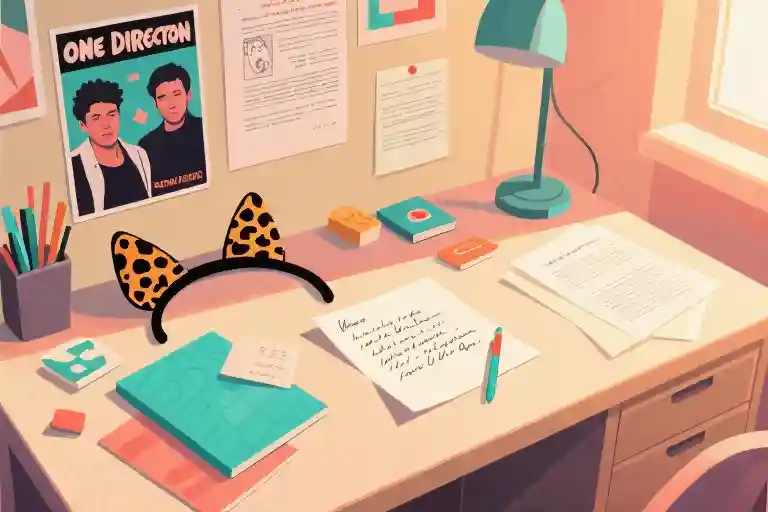The living room hummed with that particular kind of quiet excitement that comes before life-changing moments. Golden afternoon light filtered through sheer curtains, casting warm geometric patterns across my parents’ worn leather sofa where they sat leaning forward, hands clasped. My siblings had claimed the floor space, my youngest nephew perched cross-legged directly in front of the television, his Spider-Man sneakers tapping impatiently against the hardwood. The air smelled faintly of my mother’s lavender candles and the coffee my uncle kept refilling from the kitchen.
On screen, pixelated by the limitations of 2021’s video conferencing technology, my business school’s crest appeared above a scrolling list of names in crisp black type. When mine materialized – “Quynton J. – Master of Business Administration, Honors” – the room erupted in a symphony of clapping, whoops, and my nephew’s delighted shriek of “That’s Uncle Q!” My mother’s hands flew to her mouth, her wedding band catching the light as tears welled in her eyes. My father, ever the quiet pillar, simply nodded with that subtle smile that meant more than any outburst.
Yet as the celebration swirled around me, my fingers tracing the raised lettering on the diploma case in my lap, another memory superimposed itself over this joyful scene. Suddenly I was ten again, knees pressed together on a hard plastic chair, staring at the flecks in gray classroom carpet while a teacher’s voice pronounced judgment on my future. The contrast between these two moments – separated by twenty years but connected by invisible threads – took my breath away.
What no one in that sunlit living room could see was how often I’d revisited that fifth-grade conference room, how its shadows still sometimes stretched across my brightest achievements. The boy who’d been told college wasn’t in his cards had not only earned an undergraduate degree but now held proof of graduate-level excellence. Yet even now, part of me still braced for someone to tap my shoulder and say there’d been a mistake, that this success belonged to someone else.
This tension between past and present defines so many of our growth stories. We accumulate degrees, accolades, and professional achievements while carrying invisible weights from earlier chapters. The classrooms where we first learned our limitations often outlast their physical walls, their echoes influencing decisions long after we’ve left them behind.
My journey from that ashamed fifth-grader to MBA graduate wasn’t linear or inevitable. It involved false starts, relapses into self-doubt, and moments when old narratives nearly derailed me. But it also contained quiet revolutions – small acts of defiance against predetermined scripts, deliberate choices to rebuild my understanding of capability from the ground up.
As my family’s laughter filled the room and the graduation stream transitioned to the next cohort of students, I made a silent promise to my younger self. Not just to celebrate how far we’d come, but to honor the hidden work that made this moment possible – the early mornings, the rejected drafts, the vulnerability of asking for help. Because true achievement isn’t measured solely in ceremonial moments, but in the countless unseen steps between “you can’t” and “I did.”
The Sealed Childhood
The plastic chair felt cold and unyielding beneath me, its rigid surface amplifying my discomfort. I focused intently on the grey classroom carpet, tracing its industrial fibers with my eyes to avoid meeting the gaze of the woman who held my academic fate in her hands. The scent of dry-erase markers and stale coffee hung in the air, mixing with the metallic tang of my own nervousness.
My fifth-grade teacher shuffled through papers with deliberate slowness, the sound of rustling documents punctuating the heavy silence. My mother sat beside me, her posture radiating quiet defiance even before the verdict came. When the teacher finally spoke, her words fell like stones: “At this rate, college is an unlikely option for Quynton.”
In that moment, the grey carpet seemed to swallow me whole. The classroom walls pressed closer, the fluorescent lights suddenly too bright. At ten years old, I hadn’t even begun to imagine college as part of my future – yet having it declared impossible struck with surprising force. The teacher’s pronouncement crystallized into something more than an observation; it became a label, sticky and persistent, that would cling to me for years.
What happens when someone else’s words become the script we live by?
The Weight of a Single Sentence
The weeks following that parent-teacher conference saw the birth of a new internal narrative: “I am bad at school.” This simple declaration grew roots, shaping how I approached every assignment, every classroom interaction. I perfected the art of invisibility – keeping my head down during discussions, avoiding eye contact when questions were posed to the class, volunteering only for tasks I knew I couldn’t fail.
My avoidance strategies became increasingly sophisticated:
- Selective participation: Only raising my hand for questions I was 100% certain about
- Strategic seating: Choosing classroom positions that minimized teacher attention
- Performance limiting: Completing work just well enough to avoid scrutiny, but never excellently enough to stand out
These weren’t conscious decisions so much as survival mechanisms, ways to protect myself from further confirmation of my supposed inadequacy. Yet with each small retreat, the label grew heavier, more definitive.
The Ripple Effect
Middle school became an exercise in self-fulfilling prophecy. The child who’d been told he wasn’t college material now approached every academic challenge with built-in hesitation:
- Math problems were “too hard” before I even read them
- Writing assignments triggered immediate anxiety about being “found out”
- Group projects filled me with dread about disappointing peers
The irony was cruel: in trying to avoid failure, I created the exact outcomes I feared. My report cards reflected mediocre effort, which only seemed to validate the original judgment. The cycle reinforced itself with each passing semester.
A Quiet Rebellion
Yet beneath the surface of this apparent confirmation, small acts of resistance were taking root. My mother’s fiery gaze that day had planted something stubborn within me – not confidence exactly, but a refusal to completely surrender to someone else’s assessment. These flickers of defiance manifested in subtle ways:
- Lingering after class to ask a single clarifying question
- Attempting one honors-level course despite my fears
- Secretly reading ahead in textbooks to prepare for challenging material
These were baby steps, barely noticeable to outside observers. But each small act of courage created microscopic cracks in the shell of my self-doubt. It would take years for those cracks to widen enough to let in real light, but the process had begun.
The Labels We Carry
Looking back, I recognize how profoundly external judgments can shape our internal landscapes, especially when we’re too young to question their validity. That fifth-grade teacher didn’t just make an observation about my current performance – she attempted to forecast my entire academic trajectory based on a snapshot.
What she couldn’t see (what no teacher can fully see) was the invisible scaffolding surrounding each student:
- The unique learning rhythms that don’t fit standard timelines
- The personal challenges that might temporarily obscure potential
- The growth spurts – intellectual and emotional – that can transform a student’s trajectory overnight
Her pronouncement reflected a fixed mindset about intelligence and capability, one that I internalized for years before learning to challenge it. The real damage wasn’t in her words themselves, but in how thoroughly I came to believe them.
Breaking the Seal
The journey from that grey-carpeted classroom to where I stand now wasn’t linear or predictable. It involved false starts, setbacks, and moments of regression. But it also contained crucial turning points – moments when I began rewriting the script that had been handed to me.
Perhaps the most important realization came slowly: the labels others give us only have the power we choose to grant them. That fifth-grade teacher’s words held truth only because I believed them, because I allowed them to shape my actions and self-concept for years.
There’s profound freedom in recognizing that we get to decide which narratives to carry forward and which to leave behind. The childhood that felt sealed by someone else’s limited vision was actually just waiting for me to break it open.
What labels from your past might be ready for re-examination?
Redefining Greatness: The Hidden Hours Behind Every Highlight
The posters on my childhood bedroom wall told a story I desperately wanted to believe. Kobe Bryant mid-fadeaway, Tiger Woods celebrating another major, Michael Johnson blazing down the track – these frozen moments of athletic perfection reinforced what seemed obvious at the time: greatness was something you were born with, a divine spark granted only to special individuals. For years, this belief served as both comfort and prison. If excellence required innate talent I clearly lacked (as my fifth-grade teacher had helpfully pointed out), why bother striving?
Then came the summer I discovered Kobe’s 4am training regimen. Not through ESPN highlights, but in a dog-eared copy of his trainer’s notebook at the library. Page after page documented what happened when cameras weren’t rolling: predawn shooting drills, grueling conditioning sessions, meticulous film study. The numbers stunned me – 800 made jumpers before breakfast, 2,000 free throws on weekends. Suddenly, the effortless-looking game-winners made sense. They weren’t magic; they were math.
The 10,000-Hour Revelation
My investigation deepened. Tiger Woods’ father had him practicing golf swings before most kids master tying shoes. Michael Phelps trained 365 days a year, including Christmas morning. What we celebrate as talent, I realized, was actually the visible tip of an iceberg – the 1% of glory resting atop 99% invisible grind. Psychologist Anders Ericsson’s research on deliberate practice confirmed it: world-class performers across fields log approximately 10,000 hours of focused, feedback-driven effort before achieving mastery.
This discovery shattered my fixed mindset. Greatness wasn’t a genetic lottery; it was a daily choice. The difference between ordinary and extraordinary wasn’t some mystical gift – it was showing up when others slept, persisting when others quit, caring when others grew complacent.
Myelin: The Neuroscience of Repetition
The science behind skill acquisition fascinated me most. Every repeated action – whether a basketball dribble or business presentation – literally rewires our brains through myelin production. This fatty insulation coating neural pathways makes signals travel faster and more efficiently. More reps equal more myelin equals better performance. There’s no shortcut; the body rewards consistency with biological upgrades.
This understanding transformed how I approached challenges during my MBA. Where I once avoided difficult tasks fearing exposure as ‘not smart enough,’ I now embraced them as myelin-building opportunities. Complex financial models? More reps. Public speaking anxiety? More reps. Each struggle wasn’t proof of inadequacy but necessary wiring for future competence.
Rewriting My Narrative
The implications reverberated beyond academics. If greatness was cultivated rather than congenital, then my fifth-grade teacher’s assessment wasn’t prophecy – just poor observation. Her words held power only if I stopped building. This mental shift turned my MBA journey into a living experiment: what could ordinary effort, consistently applied over time, produce?
The answer came gradually – through 5am study sessions, through seeking feedback instead of avoiding it, through celebrating small wins that compounded. By graduation, I wasn’t just holding a diploma but tangible proof: greatness isn’t found, it’s forged. And the furnace is always open to those willing to step inside.
The Deliberate Practice Playbook: How I Engineered My MBA Success
The library’s fluorescent lights hummed softly as I settled into my usual corner carrel at 4:55 AM, thermos of black coffee leaving faint rings on the annotated case study before me. This was my daily sanctuary during my MBA – two uninterrupted hours where I could hear my own thoughts beneath the weight of corporate finance models and marketing frameworks. What began as survival strategy evolved into my most powerful weapon against self-doubt.
The 5 AM Cognitive Prime
Neuroscience research confirms what early risers intuitively know: the first 90 minutes after waking offer peak mental clarity. I structured this golden window for deep work immersion:
- Precision Reading Protocol (5:00-6:00)
- Color-coded annotation system:
- Blue highlights = core concepts
- Red question marks = knowledge gaps
- Green exclamation points = actionable insights
- Margin notes converting dense theory into conversational language (“If Porter’s Five Forces were a poker game…”)
- Concept Mapping (6:00-6:30)
- Transforming highlighted passages into visual frameworks using:
- Radial diagrams for interrelated concepts
- Flow charts for sequential processes
- Venn diagrams for overlapping theories
- Anticipatory Q&A (6:30-7:00)
- Generating potential cold-call questions from that day’s material
- Scripting responses aloud (strengthening neural pathways through verbalization)
This morning ritual created compounding returns – by midterm season, my annotated textbooks became coveted study aids among classmates.
The Evening Autopsy: Turning Mistakes into Muscle Memory
While others decompressed with Netflix after dinner, I conducted what Navy SEALs call “after-action reviews”:
19:00-19:30: Error Classification
- Developed a triage system for mistakes:
- Red Flags: Fundamental knowledge gaps (required textbook re-reading)
- Yellow Alerts: Application errors (triggered practice problem sets)
- Green Glitches: Careless slips (addressed through pre-work checklists)
19:30-20:30: Deliberate Repetition
- Focused exclusively on yellow/red category items using:
- The Feynman Technique (explaining concepts to an imaginary novice)
- Reverse engineering professor’s solution approaches
- Creating “wrong answer” banks to recognize decoy options
20:30-21:00: Progress Journaling
- Tracking micro-wins in a dedicated notebook:
- “Nailed discounted cash flow analysis after 3 attempts”
- “Recognized trap in 2/3 probability questions today”
This systematic approach transformed failures into targeted growth opportunities rather than evidence of inadequacy.
Psychological Armor: Three Tools That Saved Me
- The 5-Minute Meltdown Clause
- Allowing myself timed emotional releases when overwhelmed
- Setting phone timer to wail/rage/cry – then resetting when it chimed
- Surprisingly effective at preventing all-day productivity crashes
- The “Before/After” Mirror Technique
- Keeping childhood report cards visible beside current transcripts
- Physical proof of growth silenced the “imposter syndrome” whispers
- The Support Swarm System
- Maintaining categorized contact lists for specific struggles:
- Academic: Study group members
- Emotional: Childhood friends who knew my journey
- Practical: Alumni mentors who’d survived the same courses
These frameworks made the difference between barely surviving and truly thriving. The secret wasn’t magical intelligence – it was intentional, systematic effort applied consistently over time.
What surprised me most? These habits outlasted graduate school. Today, my consulting work still follows the same deliberate practice rhythms – just with client presentations instead of case studies. Because mastery isn’t a destination; it’s a way of traveling.
Consider this your invitation: What’s one deliberate practice ritual you could implement this week to build your version of greatness?
The Gentle Reckoning
The padded envelope felt heavier than it should have as I placed my MBA diploma carefully inside. Twenty-three years had passed since that grey-carpeted classroom, but my fingers still hesitated before sealing it shut. This wasn’t just mail—it was a time capsule carrying the weight of a decade’s worth of quiet defiance.
The Unwritten Letter
Three drafts of handwritten notes lay crumpled in my wastebasket. Each attempt had veered too far—some dripping with bitterness, others awkwardly formal. The final version, resting against the embossed degree, contained just twelve deliberate words:
“For your records. With gratitude for the motivation you never intended to give.”
Psychologists call this symbolic completion—the act of closing emotional loops through physical rituals. For me, this certified mail receipt would serve as my psychological period at the end of a sentence that had hung unfinished since fifth grade.
The Anatomy of a Quiet Rebellion
The packaging details became unexpectedly significant:
- The envelope: Standard USPS Priority Mail, deliberately impersonal
- The return address: My current employer’s logo, not my home
- The postmark: Our small town’s main post office, where she likely still shopped
These weren’t accidental choices. Every element whispered: I built this success without you, but you will witness it. The banality of the mailer made the message louder—this wasn’t an emotional outburst, but a factual update from the life she’d predicted I’d never have.
The Aftermath
Tracking showed delivery at 11:17am on a Tuesday. I imagined the envelope landing on a school secretary’s desk, being carried to a classroom that probably still smelled of pencil shavings and industrial cleaner. Would she remember my name? Feel remorse? Dismiss it as arrogance?
What surprised me most was the absence of elation. Instead of triumphant fireworks, I felt a quiet settling—like snow covering tire tracks in a parking lot. The validation I’d expected to feel already lived in my daily reality: in my morning coffee with colleagues discussing quarterly reports, in my niece’s wide eyes when she said “I want an office like yours when I grow up.”
The Ripple Effect
Months later, cleaning my inbox, I found an unexpected email from a former classmate:
“Saw Mrs. K at the grocery store. She mentioned getting ‘proof someone actually listened to my teaching.’ Her tone was…complicated. Thought you should know.”
The message made me smile for reasons I couldn’t articulate. Perhaps because it revealed the hidden truth about these reckonings—they’re never really about the recipient. This ritual had served its true purpose: converting my childhood shame into neutral evidence that predictions aren’t promises.
Carrying the Weight Lightly
Today, when impostor syndrome whispers during board presentations, I sometimes picture that unopened diploma copy sitting in a teacher’s desk drawer. Not as a weapon, but as an anchor—proof that the most powerful rebellions are often the quietest ones.
What surprised me most wasn’t the act of sending it, but how little I needed her response. The true closure came from recognizing that her voice had long been drowned out by better ones—including my own.
For reflection: What symbolic act might help you reclaim power from an old narrative? Not for them, but for you?
The Never-Ending Work of Growth
Even now, after years of deliberate practice and hard-won achievements, my hands still tremble before important presentations. The physical reaction surprises me each time—this visceral reminder that growth isn’t linear, that old doubts don’t disappear simply because we’ve collected degrees or accomplishments. The ten-year-old boy who once shrunk in his classroom chair still lives within me, whispering familiar anxieties when I step onto new stages.
The Emergency Toolkit
Over time, I’ve developed specific strategies to navigate these moments:
1. The Ten-Year-Old Self Dialogue
When nervousness surfaces before a speaking engagement, I’ve learned to pause and address my younger self directly: “I see you’re worried. Remember how far we’ve come? That MBA graduation? The presentations we’ve already delivered successfully? You don’t have to hide anymore.” This mental conversation acknowledges the fear while reinforcing present-day capabilities.
2. The Support Network List
My phone contains a dedicated note titled “When Doubt Creeps In”—a running list of people who’ve witnessed my growth. Before challenging moments, I review their encouraging messages. My mother’s texts (“You were born ready for this”), a professor’s email (“Your insights always add value”), even my nephew’s childish drawings with “World’s Best Uncle” scribbled across the top—these become tangible proof against imposter syndrome.
Guiding the Next Generation
The true test of growth comes when we help others navigate paths we once struggled with alone. Last summer, my twelve-year-old nephew hesitated before his middle school science presentation. Watching him bite his lip while rehearsing, I recognized the familiar shadow of self-doubt.
Instead of generic encouragement (“You’ll do fine!”), I shared my pre-speech routine:
- The 4-7-8 Breath: Inhale for 4 seconds, hold for 7, exhale for 8 (physiology impacts psychology)
- Power Pose Practice: Two minutes of confident posturing backstage (proven to reduce cortisol)
- Audience Re-framing: “They want you to succeed” vs “They’re judging me”
His eventual triumph—nervous but competent—mirrored my own journey. This is the beautiful paradox of growth: our deepest struggles become the very tools we use to lift others.
The Continuous Climb
Growth mindset isn’t about reaching some imaginary finish line where doubts cease. It’s about developing resilience tools and passing them forward. Some days feel like soaring; others require digging into that emergency toolkit. Both are valid. Both are growth.
Because the work isn’t in eliminating the ten-year-old’s fears—it’s in learning to fly despite them, and showing others how to do the same.
The Weight We Carry, The Wings We Grow
My mother’s eyes have always told stories words could never capture. That day in fifth grade, they burned with silent defiance against a teacher’s cruel prophecy. Today, as my MBA graduation flashes across the television screen, those same eyes shimmer with tears that trace the twenty-year journey between those two moments – the unspoken “I told you so” to every doubter who ever tried to write my ending.
This is the paradox of growth: we never truly shed our old selves. The ten-year-old who absorbed that classroom humiliation still lives within me, just as the college graduate who proved it wrong still lives within the man now celebrating this milestone. Our past isn’t erased by success; it becomes ballast that steadies our flight.
The Eyes That Witnessed It All
When my mother squeezes my hand during the graduation broadcast, I feel the calluses from years of working double shifts. These hands that signed permission slips and packed lunches also signed checks for textbooks when scholarships fell short. Her pride today isn’t just about the degree – it’s about every invisible sacrifice that made this moment possible.
Across the room, my nephew cheers with the unselfconscious joy only children possess. His excitement reminds me how far I’ve traveled from that shrunken fifth-grader – and how much further he’ll go without carrying the same burdens. This is why we break cycles: so the next generation can fly without old weights dragging them down.
Your #OldCocoonChallenge
We all carry remnants of past versions that doubted us. Maybe it’s:
- The coach who said you’d never make varsity
- The college counselor who suggested community college was “more your speed”
- The boss who implied you weren’t leadership material
This week, I’m starting a conversation on Instagram using #OldCocoonChallenge. Here’s how to join:
- Name the old label that once defined you
- Claim one way you’ve outgrown it
- Tag someone who needs to hear this message
Mine reads:
“#OldCocoonChallenge: ‘College isn’t for you’ – 5th grade teacher. Today I hold two degrees and teach university courses. Tagging every student who’s been underestimated.”
The Beautiful Weight
Growth isn’t about becoming weightless – it’s about growing strong enough to carry your history without being crushed by it. Those childhood wounds? They’re the reason you notice when others shrink themselves. Those past failures? They built your radar for spotting potential in the “underdogs” around you.
Like trees that grow strongest when facing resistance, we become most resilient when we integrate our struggles rather than deny them. The diploma on my wall matters, but what matters more is the man who earned it – one who still remembers what it felt like to believe he never could.
“We don’t lose our cocoons – we learn to wear them as armor.”
P.S. That fifth-grade teacher eventually received a package in her school mailbox. No angry letter, just two framed diplomas with a simple note: “For your files.” Some victories taste sweetest when served at room temperature.





